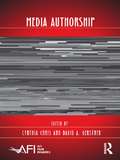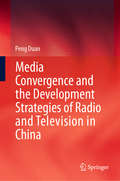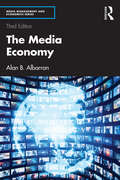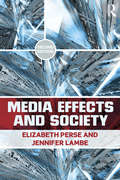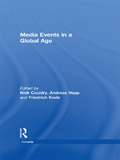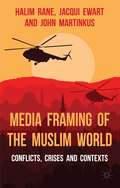- Table View
- List View
Media and Popular Music (Media Topics)
by Peter MillsA study of the relationships between music and contemporary media.
Media and the American Child
by George Comstock Erica ScharrerMedia and the American Child summarizes the research on all forms of media on children, looking at how much time they spend with media everyday, television programming and its impact on children, how advertising has changed to appeal directly to children and the effects on children and the consumer behavior of parents, the relationship between media use and scholastic achievement, the influence of violence in media on anti-social behavior, and the role of media in influencing attitudes on body image, sex and work roles, fashion, & lifestyle. The average American child, aged 2-17, watches 25 hours of TV per week, plays 1 hr per day of video or computer games, and spends an additional 36 min per day on the internet. 19% of children watch more than 35 hrs per week of TV. This in the face of research that shows TV watching beyond 10 hours per week decreases scholastic performance. In 1991, George Comstock published Television and the American Child, which immediately became THE standard reference for the research community of the effects of television on children. Since then, interest in the topic has mushroomed, as the availability and access of media to children has become more widespread and occurs earlier in their lifetimes. No longer restricted to television, media impacts children through the internet, computer and video games, as well as television and the movies. There are videos designed for infants, claiming to improve cognitive development, television programs aimed for younger and younger children-even pre-literates, computer programs aimed for toddlers, and increasingly graphic, interactive violent computer games. Presents the most recent research on the media use of young people Investigates the content of children's media and addresses areas of great concern including violence, sexual behavior, and commercialization Discusses policy making in the area of children and the media Focuses on experiences unique to children and adolescents
Media and the Make-Believe Worlds of Children: When Harry Potter Meets Pokemon in Disneyland (Routledge Communication Series)
by Maya Gotz Dafna Lemish Hyesung Moon Amy AidmanMedia and the Make-Believe Worlds of Children offers new insights into children's descriptions of their invented or "make-believe" worlds, and the role that the children's experience with media plays in creating these worlds. Based on the results of a cross-cultural study conducted in the United States, Germany, Israel, and South Korea, it offers an innovative look at media's role on children's creative lives.This distinctive volume:*outlines the central debates and research findings in the area of children, fantasy worlds, and the media;*provides a descriptive account of children's make-believe worlds and their wishes for actions they would like to take in these worlds;*highlights the centrality of media in children's make believe worlds;*emphasizes the multiple creative ways in which children use media as resources in their environment to express their own inner worlds; and*suggests the various ways in which the tension between traditional gender portrayals that continue to dominate media texts and children's wishes to act are presented in their fantasies.The work also demonstrates the value of research in unveiling the complicated ways in which media are woven into the fabric of children's everyday lives, examining the creative and sophisticated uses they make of their contents, and highlighting the responsibility that producers of media texts for children have in offering young viewers a wide array of role models and narratives to use in their fantasies. An enclosed CD provides full-color images of the artwork produced during the study.This book will appeal to scholars and graduate students in children and media, early childhood education, and developmental psychology. It can be used in graduate level courses in these areas.
Media and the Make-Believe Worlds of Children: When Harry Potter Meets Pokemon in Disneyland (Routledge Communication Series)
by Maya Gotz Dafna Lemish Hyesung Moon Amy AidmanMedia and the Make-Believe Worlds of Children offers new insights into children's descriptions of their invented or "make-believe" worlds, and the role that the children's experience with media plays in creating these worlds. Based on the results of a cross-cultural study conducted in the United States, Germany, Israel, and South Korea, it offers an innovative look at media's role on children's creative lives.This distinctive volume:*outlines the central debates and research findings in the area of children, fantasy worlds, and the media;*provides a descriptive account of children's make-believe worlds and their wishes for actions they would like to take in these worlds;*highlights the centrality of media in children's make believe worlds;*emphasizes the multiple creative ways in which children use media as resources in their environment to express their own inner worlds; and*suggests the various ways in which the tension between traditional gender portrayals that continue to dominate media texts and children's wishes to act are presented in their fantasies.The work also demonstrates the value of research in unveiling the complicated ways in which media are woven into the fabric of children's everyday lives, examining the creative and sophisticated uses they make of their contents, and highlighting the responsibility that producers of media texts for children have in offering young viewers a wide array of role models and narratives to use in their fantasies. An enclosed CD provides full-color images of the artwork produced during the study.This book will appeal to scholars and graduate students in children and media, early childhood education, and developmental psychology. It can be used in graduate level courses in these areas.
Media Archaeology and Intermedial Performance: Deep Time of the Theatre (Avant-Gardes in Performance)
by Nele WynantsThis book develops media archaeological approaches to theatre and intermediality. As an age-old art form, theatre has always embraced ‘new’ media. To create theatrical effects and optical illusions, theatre makers were ready to integrate state-of-the-art technics and technologies, and by doing so they playfully explored and popularized scientific knowledge on mechanics, optics and sound for live audiences. This book highlights this obvious but often overlooked relation between media developments and the history of intermedial theater. By considering the interplay between present intermedial performances and their archaeological traces, the authors assembled here revisit old and often forgotten media approaches and theatre technologies. This archaeology is understood less as the discovery of a forgotten past than as the establishment of an active relationship between past and present. Rather than treating archaeological remains as representative tokens of a fragmented past that need to be preserved, the authors stress the return of the past in the present, but in a different, performative guise.
Media Authorship (AFI Film Readers)
by Cynthia Chris David A. GerstnerContemporary media authorship is frequently collaborative, participatory, non-site specific, or quite simply goes unrecognized. In this volume, media and film scholars explore the theoretical debates around authorship, intention, and identity within the rapidly transforming and globalized culture industry of new media. Defining media broadly, across a range of creative artifacts and production cultures—from visual arts to videogames, from textiles to television—contributors consider authoring practices of artists, designers, do-it-yourselfers, media professionals, scholars, and others. Specifically, they ask: What constitutes "media" and "authorship" in a technologically converged, globally conglomerated, multiplatform environment for the production and distribution of content? What can we learn from cinematic and literary models of authorship—and critiques of those models—with regard to authorship not only in television and recorded music, but also interactive media such as videogames and the Internet? How do we conceive of authorship through practices in which users generate content collaboratively or via appropriation? What institutional prerogatives and legal debates around intellectual property rights, fair use, and copyright bear on concepts of authorship in "new media"? By addressing these issues, Media Authorship demonstrates that the concept of authorship as formulated in literary and film studies is reinvigorated, contested, remade—even, reauthored—by new practices in the digital media environment.
Media Authorship (AFI Film Readers)
by Cynthia Chris David A. GerstnerContemporary media authorship is frequently collaborative, participatory, non-site specific, or quite simply goes unrecognized. In this volume, media and film scholars explore the theoretical debates around authorship, intention, and identity within the rapidly transforming and globalized culture industry of new media. Defining media broadly, across a range of creative artifacts and production cultures—from visual arts to videogames, from textiles to television—contributors consider authoring practices of artists, designers, do-it-yourselfers, media professionals, scholars, and others. Specifically, they ask: What constitutes "media" and "authorship" in a technologically converged, globally conglomerated, multiplatform environment for the production and distribution of content? What can we learn from cinematic and literary models of authorship—and critiques of those models—with regard to authorship not only in television and recorded music, but also interactive media such as videogames and the Internet? How do we conceive of authorship through practices in which users generate content collaboratively or via appropriation? What institutional prerogatives and legal debates around intellectual property rights, fair use, and copyright bear on concepts of authorship in "new media"? By addressing these issues, Media Authorship demonstrates that the concept of authorship as formulated in literary and film studies is reinvigorated, contested, remade—even, reauthored—by new practices in the digital media environment.
Media Convergence: The Three Degrees of Network, Mass and Interpersonal Communication
by Klaus Bruhn JensenThe development of digital media presents a unique opportunity to reconsider what communication is, and what individuals, groups, and societies might hope to accomplish through new as well as old media. At a time when digital media still provoke both utopian and dystopian views of their likely consequences, Klaus Bruhn Jensen places these ‘new’ media in a comparative perspective together with ‘old’ mass media and face-to-face communication, restating the two classic questions of media studies: what do media do to people, and what do people do with media? Media Convergence makes a distinction between three general types of media: the human body enabling communication in the flesh; the technically reproduced means of mass communication; and the digital technologies facilitating interaction one-to-one, one-to-many, as well as many-to-many. Features include: case studies, including mobile phones in everyday life, the Muhammad cartoons controversy and climate change as a global challenge for human communication and political action diagrams, figures, and tables summarizing key concepts beyond standard ‘models of communication’ systematic cross-referencing. Major terms are highlighted and cross-referenced throughout, with key concepts defined in margin notes.
Media Convergence: The Three Degrees of Network, Mass and Interpersonal Communication
by Klaus Bruhn JensenThe development of digital media presents a unique opportunity to reconsider what communication is, and what individuals, groups, and societies might hope to accomplish through new as well as old media. At a time when digital media still provoke both utopian and dystopian views of their likely consequences, Klaus Bruhn Jensen places these ‘new’ media in a comparative perspective together with ‘old’ mass media and face-to-face communication, restating the two classic questions of media studies: what do media do to people, and what do people do with media? Media Convergence makes a distinction between three general types of media: the human body enabling communication in the flesh; the technically reproduced means of mass communication; and the digital technologies facilitating interaction one-to-one, one-to-many, as well as many-to-many. Features include: case studies, including mobile phones in everyday life, the Muhammad cartoons controversy and climate change as a global challenge for human communication and political action diagrams, figures, and tables summarizing key concepts beyond standard ‘models of communication’ systematic cross-referencing. Major terms are highlighted and cross-referenced throughout, with key concepts defined in margin notes.
Media Convergence: The Three Degrees of Network, Mass, and Interpersonal Communication
by Klaus Bruhn JensenThis second edition furthers conversations about the ongoing society-wide and worldwide digitalization of human communication. Reviewing the long lines in the history of media and communication – from writing via printing and broadcasting to computing – the book lays out three general types of media: the human body enabling face-to-face communication here and now; the technically reproduced means of mass communication across space and time; and the digital technologies integrating one-to-one, one-to-many, as well as many-to-many interactions. All these communicative practices coexist in contemporary media environments. Across cultures, genders, and age groups, people go on communicating in the flesh, via wires, and over the air, as illustrated though case studies of mobile communication on mundane matters, and of climate change as a global challenge for human communication and coexistence. The second edition includes: Updated accounts of research and public debate on digital media and communication Analyses of current social media and an emerging internet of things Systematic presentations of digital as well as traditional empirical methods Discussion of the normative implications of digitalization, including the classic rights of information and communication, and a right not to be communicated about through surveillance Interdisciplinary in scope to showcase the wide-reaching cultural consequences of media convergence, this book is ideal for advanced undergraduate students, graduate students, and scholars in the fields of media, communication, and cultural studies.
Media Convergence: The Three Degrees of Network, Mass, and Interpersonal Communication
by Klaus Bruhn JensenThis second edition furthers conversations about the ongoing society-wide and worldwide digitalization of human communication. Reviewing the long lines in the history of media and communication – from writing via printing and broadcasting to computing – the book lays out three general types of media: the human body enabling face-to-face communication here and now; the technically reproduced means of mass communication across space and time; and the digital technologies integrating one-to-one, one-to-many, as well as many-to-many interactions. All these communicative practices coexist in contemporary media environments. Across cultures, genders, and age groups, people go on communicating in the flesh, via wires, and over the air, as illustrated though case studies of mobile communication on mundane matters, and of climate change as a global challenge for human communication and coexistence. The second edition includes: Updated accounts of research and public debate on digital media and communication Analyses of current social media and an emerging internet of things Systematic presentations of digital as well as traditional empirical methods Discussion of the normative implications of digitalization, including the classic rights of information and communication, and a right not to be communicated about through surveillance Interdisciplinary in scope to showcase the wide-reaching cultural consequences of media convergence, this book is ideal for advanced undergraduate students, graduate students, and scholars in the fields of media, communication, and cultural studies.
Media Convergence and the Development Strategies of Radio and Television in China
by Peng DuanThis book discusses the development strategies of Chinese media convergence in the current, fast-changing communication environment. Drawing on both theoretical and empirical data and based on the author’s observations, focus groups, and in-depth analyses of selected Chinese radio and TV networks, it illustrates key lessons for the maintenance and future improvement of talents, advertisement, media organization management, business development, and coping strategies. Further, it outlines a framework that helps readers to consider how to use communication strategies for the construction of media convergence in the context of China by referring to theories of international communication and political communication.Presenting research on the development strategies of Chinese media convergence, it offers a systematic study of the processes through which the Chinese radio and television industries make use of proper communication strategies to have a profound global influence.
Media Criticism in a Digital Age: Professional And Consumer Considerations
by Peter B. OrlikMedia Criticism in a Digital Age introduces readers to a variety of critical approaches to audio and video discourse on radio, television and the Internet. It is intended for those preparing for electronic media careers as well as for anyone seeking to enhance their media literacy. This book takes the unequivocal view that the material heard and seen over digital media is worthy of serious consideration. Media Criticism in a Digital Age applies key aesthetic, sociological, philosophical, psychological, structural and economic principles to arrive at a comprehensive evaluation of programming and advertising content. It offers a rich blend of insights from both industry and academic authorities. These insights range from the observations of Plato and Aristotle to the research that motivates twenty-first century marketing and advertising. Key features of the book are comprised of: multiple video examples including commercials, cartoons and custom graphics to illustrate core critical concepts; chapters reflecting today’s media world, including coverage of broadband and social media issues; fifty perceptive critiques penned by a variety of widely respected media observers and; a supplementary website for professors that provides suggested exercises to accompany each chapter (www.routledge .com/cw/orlik) Media Criticism in a Digital Age equips emerging media professionals as well as perceptive consumers with the evaluative tools to maximize their media understanding and enjoyment.
Media Criticism in a Digital Age: Professional And Consumer Considerations
by Peter B. OrlikMedia Criticism in a Digital Age introduces readers to a variety of critical approaches to audio and video discourse on radio, television and the Internet. It is intended for those preparing for electronic media careers as well as for anyone seeking to enhance their media literacy. This book takes the unequivocal view that the material heard and seen over digital media is worthy of serious consideration. Media Criticism in a Digital Age applies key aesthetic, sociological, philosophical, psychological, structural and economic principles to arrive at a comprehensive evaluation of programming and advertising content. It offers a rich blend of insights from both industry and academic authorities. These insights range from the observations of Plato and Aristotle to the research that motivates twenty-first century marketing and advertising. Key features of the book are comprised of: multiple video examples including commercials, cartoons and custom graphics to illustrate core critical concepts; chapters reflecting today’s media world, including coverage of broadband and social media issues; fifty perceptive critiques penned by a variety of widely respected media observers and; a supplementary website for professors that provides suggested exercises to accompany each chapter (www.routledge .com/cw/orlik) Media Criticism in a Digital Age equips emerging media professionals as well as perceptive consumers with the evaluative tools to maximize their media understanding and enjoyment.
Media, Culture and Society in Putin's Russia (Studies in Central and Eastern Europe)
by S. WhiteAn international collection of papers focused on media, culture and society in postcommunist Russia. Contributors deploy a wealth of primary data in examining the kinds of issues that are central to our understanding of the kind of system that has been established in the world's largest country after a period of far-reaching change.
The Media Economy (Media Management and Economics Series)
by Alan B. AlbarranThis fully updated third edition analyzes the media industries and their activities from macro to micro levels, using concepts and theories to demonstrate the role the media plays in the economy as a whole. This textbook breaks new ground through its analysis of the rapidly changing and evolving media economy from two unique perspectives. First, the book explores how media industries function across global, national, household, and individual levels of society. Second, it assesses how key forces such as technology, globalization, regulation, and consumer aspects are constantly evolving and influencing media industries. This new edition incorporates thoroughly updated theory and research as well as expanded case studies that include examples from international markets such as Asia, Europe, and Latin America. It builds on the contributions of the previous edition by providing new references and current data to define and analyze today’s media markets and offers a more expansive assessment of streaming business models as well as the effects of Covid-19 on the media economy. Written in an accessible style and presenting a holistic global perspective of the role of media in the global economy, the textbook provides crucial insights for students and practitioners of media economics, media management and media industries.
The Media Economy (Media Management and Economics Series)
by Alan B. AlbarranThis fully updated third edition analyzes the media industries and their activities from macro to micro levels, using concepts and theories to demonstrate the role the media plays in the economy as a whole. This textbook breaks new ground through its analysis of the rapidly changing and evolving media economy from two unique perspectives. First, the book explores how media industries function across global, national, household, and individual levels of society. Second, it assesses how key forces such as technology, globalization, regulation, and consumer aspects are constantly evolving and influencing media industries. This new edition incorporates thoroughly updated theory and research as well as expanded case studies that include examples from international markets such as Asia, Europe, and Latin America. It builds on the contributions of the previous edition by providing new references and current data to define and analyze today’s media markets and offers a more expansive assessment of streaming business models as well as the effects of Covid-19 on the media economy. Written in an accessible style and presenting a holistic global perspective of the role of media in the global economy, the textbook provides crucial insights for students and practitioners of media economics, media management and media industries.
Media Effects and Society (Routledge Communication Series)
by Elizabeth M. Perse Jennifer LambeGrounded in theoretical principle, Media Effects and Society help students make the connection between mass media and the impact it has on society as a whole. The text also explores how the relationship individuals have with media is created, therefore helping them alleviate its harmful effects and enhance the positive ones. The range of media effects addressed herein includes news diffusion, learning from the mass media, socialization of children and adolescents, influences on public opinion and voting, and violent and sexually explicit media content. The text examines relevant research done in these areas and discusses it in a thorough and accessible manner. It also presents a variety of theoretical approaches to understanding media effects, including psychological and content-based theories. In addition, it demonstrates how theories can guide future research into the effects of newer mass communication technologies. The second edition includes a new chapter on effects of entertainment, as well as text boxes with examples for each chapter, discussion of new technology effects integrated throughout the chapters, expanded pedagogy, and updates to the theory and research in the text. These features enhance the already in-depth analysis Media Effects and Society provides.
Media Effects and Society (Routledge Communication Series)
by Elizabeth M. Perse Jennifer LambeGrounded in theoretical principle, Media Effects and Society help students make the connection between mass media and the impact it has on society as a whole. The text also explores how the relationship individuals have with media is created, therefore helping them alleviate its harmful effects and enhance the positive ones. The range of media effects addressed herein includes news diffusion, learning from the mass media, socialization of children and adolescents, influences on public opinion and voting, and violent and sexually explicit media content. The text examines relevant research done in these areas and discusses it in a thorough and accessible manner. It also presents a variety of theoretical approaches to understanding media effects, including psychological and content-based theories. In addition, it demonstrates how theories can guide future research into the effects of newer mass communication technologies. The second edition includes a new chapter on effects of entertainment, as well as text boxes with examples for each chapter, discussion of new technology effects integrated throughout the chapters, expanded pedagogy, and updates to the theory and research in the text. These features enhance the already in-depth analysis Media Effects and Society provides.
A Media Epigraphy of Video Compression: Reading Traces of Decay
by Marek JancovicThis book explores the historical interrelationships between mathematics, medicine and media, and offers a unique perspective on how video compression has shaped our relationship with moving images and the world. It situates compression in a network of technological, visual and epistemic practices spanning from late 18th-century computational methods to the standardization of electrical infrastructure and the development of neurology throughout the 1900s. Bringing into conversation media archaeology, science and technology studies, disability studies and queer theory, each chapter offers an in-depth look at a different trace of compression, such as interlacing, macroblocking or flicker. This is a story of forgotten technologies, unusual media practices, strange images on the margins of visual culture and inventive ways of looking at the world. Readers will find illuminating discussions of the formation of complex scientific and medical systems, and of the violent and pleasurable interactions between our bodies and media infrastructure.
Media Events in a Global Age (Comedia)
by Nick Couldry Andreas Hepp Friedrich Krotz"This volume assembles an estimable range of critical analyses of one of the most important mediated artifacts of the modern world—the media event. The authors challenge the construct, extend its usefulness, expand its theoretical basis and application, and examine media events in a far larger and richer context than ever before. Students of global media today are well served by this superb collection of essays."David Morgan, Duke University, USA "A welcome and worthy successor to Dayan and Katz’s path-breaking study that expands and enriches the discourse on global media events." Daya Thussu, University of Westminster, UK "This is an excellent collection, that will enable new kinds of argument about, and hopefully research into, the spectacular functions of the contemporary media." Graeme Turner, University of Queensland, Australia We live in an age where the media is intensely global and profoundly changed by digitalization. Not only do many media events have audiences who access them online, but additionally digital media flows are generating new ways in which media events can emerge. In times of increasingly differentiated media technologies and fragmented media landscapes, the ‘eventization’ of the media is increasingly important for the marketing and everyday appreciation of popular media texts. The events covered include Celebrity Big Brother, 9/11, the Iraq war and World Youth Day 2005 to give readers an understanding of the major debates in this increasingly high-profile area of media and cultural research.
Media Events in a Global Age (Comedia)
by Nick Couldry Andreas Hepp Friedrich Krotz"This volume assembles an estimable range of critical analyses of one of the most important mediated artifacts of the modern world—the media event. The authors challenge the construct, extend its usefulness, expand its theoretical basis and application, and examine media events in a far larger and richer context than ever before. Students of global media today are well served by this superb collection of essays."David Morgan, Duke University, USA "A welcome and worthy successor to Dayan and Katz’s path-breaking study that expands and enriches the discourse on global media events." Daya Thussu, University of Westminster, UK "This is an excellent collection, that will enable new kinds of argument about, and hopefully research into, the spectacular functions of the contemporary media." Graeme Turner, University of Queensland, Australia We live in an age where the media is intensely global and profoundly changed by digitalization. Not only do many media events have audiences who access them online, but additionally digital media flows are generating new ways in which media events can emerge. In times of increasingly differentiated media technologies and fragmented media landscapes, the ‘eventization’ of the media is increasingly important for the marketing and everyday appreciation of popular media texts. The events covered include Celebrity Big Brother, 9/11, the Iraq war and World Youth Day 2005 to give readers an understanding of the major debates in this increasingly high-profile area of media and cultural research.
Media Experiences: Reality TV Producers And Audiences
by Annette HillMedia Experiences: Engaging with Drama and Reality Television travels across people and popular culture, exploring the pathways to engagement and the various ways in which we shape and are shaped by the media landscapes in which we move. This exploration includes the voices and bodies, sights and sounds of audiences as they experience entertainment through television drama, reality TV, at live events, and within digital television itself as actors, participants and producers. It is about the people who create the drama, live events and reality entertainment that we experience. This book traverses the relationships between producers and audiences in shared places of a media imagination. Annette Hill’s research draws on interviews and observations with over 500 producers and audience members to explore cultures of viewing across different genres, such as Nordic noir crime drama The Bridge, cult conspiracy thriller Utopia, and reality television audiences and participants in global formats MasterChef and Got to Dance. The research highlights how trends such as multi-screening, catch up viewing, amateur media and piracy work alongside counter-trends in retro television viewing where people relish the social ritual of watching live television, or create a social media blackout for immersive viewing. Media Experiences bridges the divide between industry and academia, highlighting how producers and audiences co-create, shape and limit experiences within emerging mediascapes.
Media Experiences: Reality Tv Producers And Audiences (PDF)
by Annette HillMedia Experiences: Engaging with Drama and Reality Television travels across people and popular culture, exploring the pathways to engagement and the various ways in which we shape and are shaped by the media landscapes in which we move. This exploration includes the voices and bodies, sights and sounds of audiences as they experience entertainment through television drama, reality TV, at live events, and within digital television itself as actors, participants and producers. It is about the people who create the drama, live events and reality entertainment that we experience. This book traverses the relationships between producers and audiences in shared places of a media imagination. Annette Hill’s research draws on interviews and observations with over 500 producers and audience members to explore cultures of viewing across different genres, such as Nordic noir crime drama The Bridge, cult conspiracy thriller Utopia, and reality television audiences and participants in global formats MasterChef and Got to Dance. The research highlights how trends such as multi-screening, catch up viewing, amateur media and piracy work alongside counter-trends in retro television viewing where people relish the social ritual of watching live television, or create a social media blackout for immersive viewing. Media Experiences bridges the divide between industry and academia, highlighting how producers and audiences co-create, shape and limit experiences within emerging mediascapes.
Media Framing of the Muslim World: Conflicts, Crises and Contexts
by John Martinkus H. Rane J. EwartMedia Framing of the Muslim World examines and explains how news about Islam and the Muslim world is produced and consumed, and how it impacts on relations between Islam and the West. The authors cover key issues in this relationship including the reporting on war and conflict, terrorism, asylum seekers and the Arab Spring.




